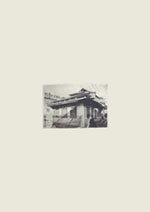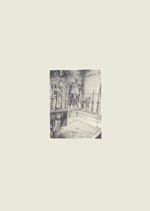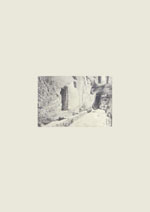RICHARD
GRAYSON
Tombs
of Christ - 2006/7
60
x 84 cm - pencil on paper
.
Sites
identified as the tomb of Christ
L-R: Talpiot, Jerusalem Israel; Aomori, Japan; Kashmir, India; Kolgata,
Jerusalem, Israel;
The Garden Tomb, Jerusalem Israel
 |

Installation
view
Obscurum per obscurius, Tallinna Kunstihoone, Estonia 2008
|
The Tombs of Christ is a series of five pencil drawings of buildings, caves mounds and excavations all of which are believed to be the burial place of Jesus Christ. In traditional Western Art, the representations of the Tomb are different and various, but they all presume a singular historical site where the fundamental miraculous event of the Christian belief system - the resurrection of Christ - took place. This event moved the figure of Christ from the world of Men to the world of God - from natural to supernatural, and it is the promise to all believers is that they too will share this life after death. The different representations in this series, drawn from various websites, share the traditional diversity of appearance but suggest instead a complex diversity of belief, tradition, and narrative. Some of the represented sites are more orthodox than others. The mound in Jerusalem where the church of the Holy Sepulchre was built in the third century AD was traditionally considered to be the site of Golgotha by the cities Christians although covered by a temple to Venus. In 326 Constantine the Great ordered the site uncovered and built his church to enclose a rock-cut tomb and the place that the crucifixion was meant to have taken place. Saint Helena, Constantine's mother, reinforced this identification through reputedly finding three nails from the true cross in the area. In 1842 German scholar Otto Thenius proposed a rocky outcrop that lay outside the walls of the city as Golgotha, and General Charles Gordon - A British Military Hero - 'Gordon of Khartoum' identified a nearby tomb as the real burial place. This 'Garden', or Gordon tomb was rapidly embraced by the Anglican and Protestant Churches as the real Tomb of Christ, but recently this formal support has been withdrawn although the Garden Tomb remains a destination for pilgrims and is considered by many a holy place. A third site five kilometers south of Old Jerusalem has been recently popularised by the film director James Cameron as the final resting place of Jesus as well as his family. The Talpiot tomb lies near the bus station and was first discovered in 1980. The wall carries an inscription that has been translated as 'Jesus Son of Joseph' - although this reading is disputed - and it contains human remains and carvings. In 2007 a program was broadcast on the Discovery Channel, produced by Cameron, which argued that the chamber contained the remains of Jesus, alongside those of Mary and of Mary Magdalene. One of two neighbouring mounds that can be found in the small village of Herai, Shingo, Northern Japan, is identified as the tomb of Christ. According to this tradition, Jesus spent 11 years in Japan from the age of 22, before returning to Galilee. At the crucifixion, it was his twin brother, Isukiri on the cross in his place and Jesus himself fled across Siberia and Alaska back to Japan to this village where he married, sired three daughters and became a rice farmer who died at the age of 106. Descendents of the family are reputed to still live in the area. The mound next to his tomb is said to contain his brother's ear and a lock of the hair of the Virgin Mary. In the old town of Sringar Kashmir lies a building that holds the tomb of 'Yuz Asaph' (Jesus the Gatherer) and a carving of a pair of feet with what appears to be scars on them. The enclosed tomb faces in an east west orientation rather than the traditional Indian north-south one, suggesting that there may be a Jewish influence in its architecture. According to Hindu belief Jesus survived the crucifixion to travel through Asia and India preaching the one-ness of God. This voyage is recorded in different documents, the Hindu Bhavishya Maha Purana and the Buddhist St Issa Scroll. He lived to the age of 120 years and was interred at this site. |



